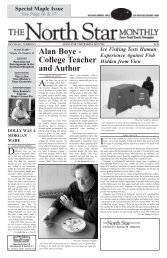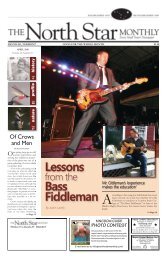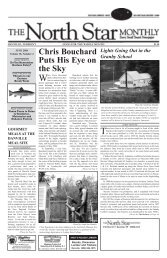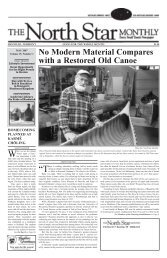March - The North Star Monthly
March - The North Star Monthly
March - The North Star Monthly
Create successful ePaper yourself
Turn your PDF publications into a flip-book with our unique Google optimized e-Paper software.
16 <strong>The</strong> north <strong>Star</strong> <strong>Monthly</strong> <strong>March</strong> 2006<strong>The</strong> Story of Maple:<strong>The</strong>re’s Gold in Those Trees(Continued from Page 1)combination of the two. Yet, regardlessof the method, the basic principleis the same. Sap is collected fromtrees, and water is removed, primarilyby boiling, to concentrate the sapinto syrup. Nothing is added, andnothing is removed but water.Maple SapIt all starts with sap from the tree.In the spring, sap from the sugarmaple contains a small quantity ofthe sugar, sucrose. <strong>The</strong> concentrationof sucrose in sap is usually about twopercent by weight, although thisvaries from tree to tree and rangesfrom one to more than four percent.Enzymes and other materials fromthe tree are present in small quantities,and it is these that will give ourmaple syrup its distinctive flavor.Sap is collected by drilling tapholesthrough the outer bark into thetrunk of the tree. Tapholes are usually5/16” in diameter and about 2”deep. <strong>The</strong> sugarmaker takes care todrill the holes sparingly so the treesare not damaged and will continue tothrive for generations. Trees that areabout 10 inches in diameter (ahealthy sugar maple takes 40 years toreach this size) to 18 inches in diameterwill have a single taphole. Largertrees may have two or three.Each hole is fitted with a metal orplastic spout so the sap doesn’t rundown the side of the tree. <strong>The</strong> spoutis placed (literally tapped) into thehole, and it conveys the sap into abucket or plastic tubing. Sap will dripfrom the hole when the weather conditionsare right. A nighttime freezedraws water into the roots from thesurrounding soil and causes a slightsuction within the tree. As the woodthaws, the sap is under pressure for awhile and emerges from the hole andruns from the spout.collecting Sap with BucketsIn Vermont, sugarmakers maycollect sap from a few taps providingjust family with syrup and or from asmany as 40,000 taps. <strong>The</strong> tappedtrees together, however few or many,are described as the sugarbush.<strong>The</strong> traditional method of sapcollecting is to hang a bucket fromthe hook on the spout. Sap fills thebucket, and each day, or even morefrequently, someone must empty thebucket into a gathering tank on a tractor-drawnwagon or perhaps a horsedrawnsleigh. This traditional methodis still used in many sugarbushes,especially those with sufficient laboravailable to handle the buckets, orwhere land is very flat, or where treesare too spread out to make plastictubing practical. It is a rare treat tofind horses in the woods at sugaringtime.collecting Sap with Tubing<strong>The</strong> more common means ofcollection today is to collect sap witha network of plastic tubing, whichbrings the sap to a storage tank at acentral and accessible location.Tubing eliminates the need to gofrom tree to tree. Small diameter tubingruns from each tree, joining largertubes called the pipeline or mainline,which conducts the sap by theforce of gravity down to the tank.Many sugarmakers increase thenatural flow of sap by attaching avacuum pump to the tubing. <strong>The</strong>vacuum pump draws the sap andkeeps it moving, so that it arrivespromptly - cold and clear at the sugarhouse.Compared to buckets, vacuumtubing increases the sap yieldfrom each taphole and tree.Installing and maintaining a tubingsystem can be a considerableundertaking even for experiencedindividuals. Most tubing is left in thewoods year round, and the sugarmakerwill spend hours maintainingthe system during the summer andfall, clearing fallen limbs and lookingfor animal damage. <strong>The</strong> task ofmaintenance continues through thewinter and deep snow and well intothe actual sugaring season, when it isnecessary to regularly check the systemfor leaks.<strong>The</strong> SugarhouseWhether by tubing, horse drawnsleigh or by other means, the sapends up at the sugarhouse. It is therethat sap meats the heat and the boilingdown and the condensation of thesap takes place. <strong>The</strong> evaporator is inthe sugarhouse, as may be otherequipment used for converting sap tosyrup. Some sugarhouses are smalland quite primitive while others arelarge and modern and may contain,in addition to the syrup makingequipment a large facility for canningsyrup or for making candy and othermaple products.Every sugarhouse will have avent or stainless steel chimney toexhaust the vast quantities of steamproduced in boiling the sap. It is thesight of this steam that alerts you toan evaporator operating and the sugarmakerboiling maple sap intosyrup.Boiling the SapOnce the sap arrives at the sugarhouse,it must be boiled promptly.Warm sap will break down, whichwill make darker, stronger tastingsyrup. If not boiled soon enough, thesap will spoil.Boiling takes place in the evaporator,which is a series of rectangularmetal pans mounted on a large basecalled an arch. <strong>The</strong> heat is located inthe arch. <strong>The</strong> evaporator may be assmall as 2 feet by 4 feet, or as large as6 feet by 20 feet, depending on thesize of the sugarbush and the volumeof sap to be boiled. Traditionally, sugarmakersburned wood in their archto generate heat for boiling, buttoday, many use oil for its convenienceand control. In any case, a hotfire is necessary to drive the waterfrom the sap.In the evaporator, the sap followsa circuitous path through the pans asit boils and becomes thicker as itnears the stage of finished syrup.First the sap enters the back or “flue”pan, which has deep channels orflues to maximize contact betweensap and heat. <strong>The</strong> boiling is vigorousand clouds of steam are produced.Float valves allow additional sap toenter the flue pan as water is continuallyboiled out of the sap, and thismaintains the sap level for efficientboiling.<strong>The</strong>n the sap enters the front, or“syrup” pan, which is divided by partitionsinto three or more compartments,open at each end. As the sapmoves through the syrup pan, itincreases in density as more andmore water is boiled off. When itreaches the end of the pathway,approximately 40 gallons of waterhave been boiled away for eachremaining gallon of syrup, and theliquid is at the right temperature (7.1°above the boiling point of water) anddensity (66.9% sugar), and the liquidhas reached the point that we recognizeas maple syrup. At that momentthe sugarmaker opens a valve anddraws off a batch of the liquid beforeit gets even more dense and burns.finishing the SyrupOnce a batch of syrup has beendrawn off, there are several moresteps before it is stored. First, it ischecked for density (sugar content)with an hydrometer. <strong>The</strong> hydrometeris a pre-calibrated float which balancesin syrup at its ideal density.<strong>The</strong>n the syrup is filtered toremove the gritty substance calledniter. Niter is a natural, harmlessmaterial, which is from minerals inthe tree that separate from the sap asit is boiled. To remove the niter, thehot syrup is passed through a woolcone filter or pushed by a pumpthrough a filter press.<strong>The</strong> filtered syrup is clear andgolden and ready to be packed orconsumed.Finally the syrup is taste- andcolor-graded, to determine which ofthe Vermont grades (Fancy, MediumAmber, Dark Amber or B) will beplaced on the label. At this point thesugarmaker will draw the syrup intosmall containers for retail sale or intolarge steel drums to be stored andopened later for repacking into smallcontainers.new TechnologyIn a modern sugarhouse youmay see some of the new technologythat helps make syrup productionmore efficient. One of the most interestingpieces of equipment is thereverse osmosis machine. Thisworks like a water purifier in reverse,pushing the sap through a fine membraneto separate pure water from thesugar, and thereby concentrates thesap before boiling. Reverse osmosiscan remove as much as three quartersof the water from sap, saving a greatdeal of time and fuel in boiling.Another innovation is the steamrecovery device, which is a largemetal box that sits over the flue panand uses steam energy rising fromthe pan to preheat incoming sap andstart the process of evaporation. Inaddition, this becomes a source ofclean hot water.Some sugarmakers use an electronicdevice that automaticallyopens the draw off valve to releasethe syrup at the moment it reachesthe proper density.“liquid Gold”Whether you visit a sugarhousewith traditional methods or modernstate of the art systems, you will seehard work while the sap is running.Like farmers in general, sugarmakersare proud of their operations andpleased to describe the unique features,even those of their own invention,that are involved in the processof making syrup. While visiting, youwill have a chance to taste and buysyrup or other maple treats, made allthe more meaningful by your conversationand understanding of whatit takes to create Vermont’s “liquidgold.”<strong>The</strong> <strong>North</strong> <strong>Star</strong> appreciates considerablehelp in the description ofthis annual process from the VermontMaple Sugar Makers’ Association.(See www.vermontmaple.org)Vermont sugar makers are thereason that Vermont offers the largestproduction of maple syrup in theUnited States providing about 37percent of the total U.S. crop. <strong>The</strong>reare approximately 2,000 maple producersin Vermont, who in 2000made an estimated 460,000 gallonsof maple syrup with a value ofapproximately $13.3 million. Datasince 1975 provided by the NewEngland Agricultural StatisticsService shows an annual variationbetween a low of 275,000 gallons in1987 and 2001 and a high of 570,000gallons in 1992.<strong>The</strong>re are four grades of RealVermont Maple Syrup, and thedebate as to which is better is arguedyear round. It’s a personal preference,but there is little debate about the useof Vermont pure maple syrup on pancakesor waffles. We also offer theseproven recipes for those of you wonderingwhat to do with syrup afterbreakfast. Try these and you’ll wonderno more.Maple roasted PecansNew England Culinary Institute4 cup pecan halves1 cup powdered sugar2 oz. maple syrupHeat pecans and powdered sugarin a saute pan over low-medium heatuntil caramelized, folding constantly.When the sugar has almost completelycaramelized, stir in the maplesyrup. Cook for 3 more minutes, stirringconstantly. Spread evenly on asheet pan lined with parchment paperand separate the pecans. Let cool andrefrigerate.Maple Teriyaki SalmonCatherine Stevens, Jericho, VT1/3 cup apple juice1/3 cup maple syrup3 tbsp. soy sauce2 tbsp. finely chopped onion1-2 minced garlic cloves4 salmon filletsIn a bowl, combine the first fiveingredients; remove 1/2 cup for bast-Acupuncturein the <strong>North</strong>east KingdomAncient Wisdom. Modern Medicine.Dedicated to your health and well beingAmy Wheeler & Barry FudimLicensed & National Board CertifiedGoodrich’s Maple Farm2427 US Rt. 2, Cabot, VT 05647(802) 426-3388goodrichsmaple@yahoo.com www.goodrichmaplefarm.comAWARD-WINNING MAPLE SYRUP & PRODUCTSRetail Wholesale Mail OrderSugarhill SMA XL JugsRO Filters, Sap Filters &Other Sugaring Suppliesoffices:Barnet, VT and Hanover, NHBy appointment: (802) 633-2876Custom Tubing Installation & ConsultationOpen Monday-Saturday 9-5, Closed Sundays & Holidays
















